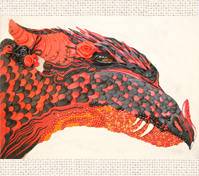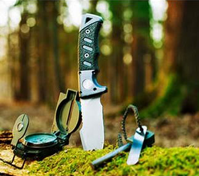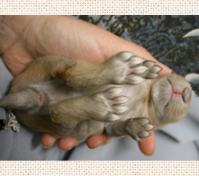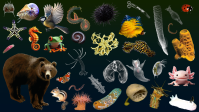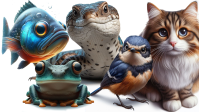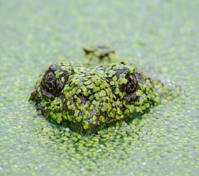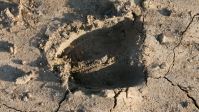5th grade
Activities:
- Investigate how ancient myths and monsters were inspired by real animal traits
- Examine detailed engravings and depictions of legendary beings
- Learn how to create identification keys starting from simple organisms like bacteria
- Design their own unique identification key for mythical creatures
- Play an engaging game, "Guess Who's Hidden in the Picture," to conclude the lesson
Activities:
Equator Quest
- Identify temperate forests by examining photos and distinguishing them from other biomes
- Use a digital field guide to identify characteristic plants and learn botanical terms
- Find animals that do not belong in the temperate forest biome by analyzing range maps
- Recognize animals by their sounds
- Identify common items made from wood
Activities:
- Learn how to dress, pack, and prepare for a journey through the forest
- Read cloud patterns to predict weather and use constellations for navigation
- Identify edible berries and medicinal plants for first aid in the wild
- Use survival techniques like fire-starting, water purification, and fishing
- Follow rivers and natural signs to find their way back to civilization
Equator Quest
Activities:
- Explore the equator’s climate zones through an interactive world map
- Dress appropriately for tropical weather challenges
- Identify venomous snakes and learn about their dangers
- Understand symptoms and prevention of tropical diseases
- Discover and classify the rich biodiversity of the Amazon, Congo, and Indonesian jungles
Activities:
- Navigate common household risks like faulty appliances, fires, and injuries
- Make safe choices in outdoor scenarios — from sunburns to stray dogs
- Practice storm safety and water safety with realistic scenarios
- Identify warning signs, assess risks, and take responsible action
- Build independence, awareness, and confidence in everyday decisions
Animal and Human Body Language
Activities:
- Interpret the mood of cats based on their body language
- Recognize signs that a dog might be dangerous
- Watch and analyze cat training stages from no response to perfect command execution
- Identify which parts of the human face express emotions and experiment with illustrations
- Determine if a person is a kind storyteller or a villain by their facial expression
- Learn to spot signs of lying and apply this knowledge in practice
Pet Care
Activities:
Activities:
- Learn how to choose a suitable pet
- Understand how to create a proper habitat for different pets
- Explore the concept of biomes and identify them on a map
- Discover appropriate feeding practices for pets
- Recognize basic signs of pet health issues and when to seek veterinary help
Multiple Intelligences in Animals
Activities:
- Study the "Multiple Intelligences" concept and its applicability to animals.
- Research and comparison of ten animals with sufficiently high intelligence based on ten criteria: linguistic intelligence, ability to count, problem-solving skills, spatial intelligence, trainability, multiple intelligences, empathy, self-awareness, ability to adapt to the environment, and sense of humor.
- Practical assignment: attempt to replicate the knots that a weaver bird ties when creating its nest.
Activities:
- Understand how the animal kingdom differs from other kingdoms
- Sort animals by their phyla
- Determine which animal is being discussed in the medieval text
- Draw a coat of arms for the animal phylum according to the rules of heraldry
Activities:
- Selection of suitable habitats for different vertebrates
- Sorting vertebrates into fish, amphibians, reptiles, birds, and mammals
- Identifying common characteristics of fish, amphibians, reptiles, birds, and mammals
- Drawing the coat of arms of the class of mammals according to the rules of heraldry
Amphibians
Activities:
Activities:
- Studying the characteristics of amphibians and identifying the features that make them amphibians.
- Learning about the life of a frog - whether it is active at night or during the day, what it does in winter, what it can eat, and what can eat it.
- Mimicry and warning coloration of frogs: finding well-hidden frogs and learning about frogs we need to hide from.
- Game "Who is the odd one out": sorting vertebrates into amphibians and all others.
- Assembling a diagram of the "life cycle of frogs."
Animal Tracking
Activities:
Activities:
- Identify animals by their footprints
- Analyze bite marks and tree damage to infer animal activity
- Recognize animals based on their droppings
- Match animals with appropriate natural shelters (burrows, hollows, lodges, etc.)
- Locate camouflaged animals hidden in plain sight
- Interpret real wildlife photos and explain what animals were doing based on visible signs
